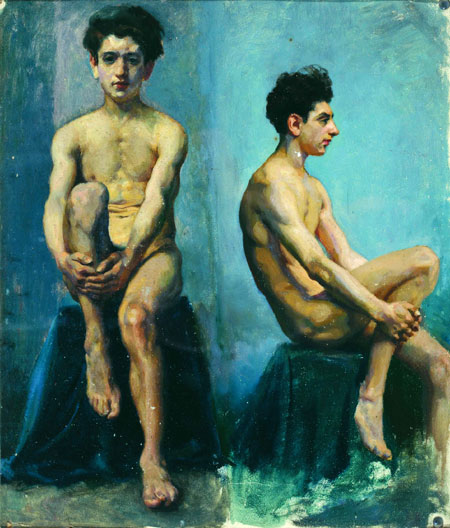China's modern art history in pictures
 0 Comment(s)
0 Comment(s) Print
Print E-mail China Daily, December 28, 2012
E-mail China Daily, December 28, 2012
The Central Academy of Fine Arts' museum is presenting 40 oil paintings the institution discovered in its storehouse. They include works from the school's teachers and students more than six decades ago, bringing back memories of the former Beiping Art School.
|
|
|
A sketch by Xu Beihong, one of the rarest exhibits displayed at the CAFA show. [Photo provided to China Daily] |
CAFA is also appealing for donations of artworks and materials from members of the public to provide a more complete picture of the school, which forms an important episode in China's modern art history.
The Beiping Art School, the brainchild of famous educator Cai Yuanpei, was founded in 1918. It was merged with the third campus of North China University in 1950 to form CAFA.
"The school was born at a time when China was aspiring to modernize, including in the aspects of arts and culture," says CAFA Art Museum director Wang Huangsheng. "Since its opening, the school attracted and cultivated a lot of artists and art educators, who immediately or later became influential figures."
But the school's achievement has been underrated up until the present day, he adds. "It is mainly because of the political turbulence and wars, which resulted in frequent changes in the school's subject planning, personnel and administrative distribution."
He says very few of the artworks and documents related to the school were collected, preserved and researched.
At the CAFA museum exhibition, most of the artworks on display are made public for the first time. Among the artists include Chinese who studied fine arts in Europe or their students, including Wu Zuoren, Chang Shuhong and Ai Zhongxin.
On show are rare paintings, such as a front and side sketch of the human body, which Xu Beihong created during his study in France. Xu headed the Beiping Art School from 1928-33 and 1946-49.
It also displays works of painters with a small oeuvre, for instance, Woman in Manchu Attire by Wu Fading and several large portraits by Li Yishi. They were among the first Chinese students of fine arts in Europe, from the late Qing Dynasty (1644-1911) until 1949.
After their return to the homeland, both artists pioneered the study and promotion of Western painting in Beijing's art circle.
"I find several of Li Yishi's works in the 1920s quite impressive, because they demonstrated Chinese artists' early exploration to employ traditional skills in oil painting," says Xu Bing, artist and CAFA's vice-president.
"Li's portrait of Chen Shizeng in 1920 deserves special attention. Chen, then a famous painter and art educator, spearheaded the renewal of Chinese literati painting. The two adopted different art approaches but befriended each other in life," he says.
The exhibition also offers a glimpse of the short-lived yet glamorous artistic career of Qi Zhenqi.
Qi, a favorite student of Xu Beihong, taught at the school but died in his early 30s. He left few but valuable paintings. His works Dongdan Bazaar and Suburb Residents give a detailed description of ordinary people's lives.
Cao Qinghui, CAFA professor and the exhibition's curator, says: "The diverse styles and quality (of the works) show the extent of the development of Western painting in Beijing."
But he says the current collection of Beiping Art School period is not enough to reflect the school's complete historical evolution.
"Many artworks of significance are absent from the storage. For instance, we haven't found any paintings from teachers who learned Western painting in Japan.
"We need to establish a systematic donation mechanism to enrich the collection," he says. Museum director Wang hopes the exhibition can inspire more people to contribute to the research of the school's art legacy.







Go to Forum >>0 Comment(s)